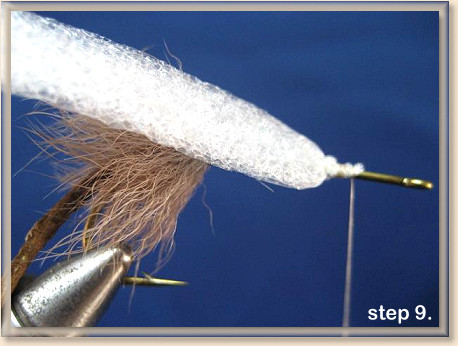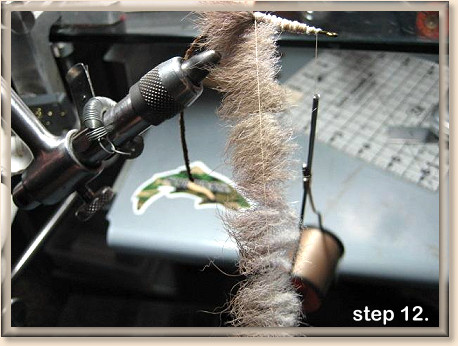 |
 Snowshoe Rabbit (Hair Mouse)
|
|
|
Method: Step 1. Start the thread at the bend and wrap a few turns to secure the thread. A lot of tiers would rough up the hook before tying the tail. It's really up to you. I personally don't think it matters. Just make sure you make a thread base so the material doesn't shift to one side.
 Step 2. After making a thread base you'll tie in the tail. The rule of thumb when measuring the length of the tail is two an a half times the hook shank. I'm using a shammy you dry off your car with. I'm sure you've seen them, they're yellow. I color mine with a brown prism color marker. How to cut the tail is start the cut larger to small keeping it tapering all the way down. It doesn't need to be real wide so make note of that. When tying it in make sure you at least tie in about an inch in length so I doesn't slip out from a fishes mouth.
 Step 3. Ok, your going to tie three clumps of snow shoe rabbit for the tail. The one on the top will be a little more then on the sides. When cutting this out from the rabbit foot make sure you cut all the way down so you get the longest amount you can. You'll find that at the tip of the foot and a little ways down is going to be the longest hair on the foot. Cut three clumps and do like you would with deer hair, pull out any excess hair that will create added bulk when tying this in. Tie the first clump on the top on the hook shank. How you will measure the length is kind of figuring out the good part of the hair and where the light part ends at the ends where you cut it.
 Step 4. Notice the amount of hair that is tied down on the hook shank. When tying the tail in, don't go crazy with thread wraps everytime you tie in a clump because you will have too much build. After you tie in the other two clumps then you can make enough thread wraps to secure everything in. After you're finish go ahead and add some glue to hold it together. I tie the first clump to the side facing me, then do the opposite side.

 Showing you the top profile.
 Step 5. Take some closed cell foam and cut a length about four inches. When making the cut you don't want it to be too wide because you're going to wrap around the shank like you would thread once you tie it in.
 This is about the width you need.
 Step 6. Advance your thread about three thirds up the length of the hook shank. This is a reference point where the ears will be tied in. At one end of the foam cut an angle and tie it in with the point is facing towards the eye of the hook.
 Step 7. Wrap the foam back until you meet up with the tail and back up where you tied it in at. Cut the excess off if you have any.
 Step 8. Tie over the foam keeping the wraps side by side so you secure the foam close to the hook shank. You don't want to leave any spaces of foam sticking out because of the hair that needs to be tied all the way up the hook shank. You need an even base to accomplish this right.
 Step 9. You'll need to prep the hair before putting it in the dubbing loop. Cut five clumps of hair and pull any excess out of the bottom where you made the cut. Make a dubbing loop long enough to put five clumps of hair in. When you add the clumps make sure you keep the hair out on one end and none on the other end of the loop. What I mean by that is you don't want to put the clump in the loop where the hair is in the center. Remember you need long hair to make the mouse look right. Another thing you can do is cut any hair that is sticking out the other side. You really don't want to do this if you don't have to. This might force the hair to shift and fall out of the dubbing loop. The key is to put it in there correctly the first time you out it in the loop. If you notice how I have mine, you can see the hair needs to be cut on one end. What I do is once I get the hair in the loop and close it, I push with my finger on the end that needs to be closest to the thread loop.
 Step 10. Now make a dubbing loop and wind to the back where you tied in the tail. Cut five clumps of hair off the rabbit. The best place to do this is at the front of the foot. That's the longest part of the hair which you need to make the mouse look right. You'll also need to prep the hair before putting it inside the loop. How you do that is the same way you did with the hair before tying in the tail. Any little baby hairs or excess hair needs to be pulled out. It's the same way you would do deer hair. Grab the tips and pull the ends with the other hand. Once you've prepped all five clumps then add them to the loop. Notice in the picture how I did mine. You can see on the right side the hair is shorter than the left side. The next thing you want to do is after you have it in the loop and closed is cut the ends close to the thread. The key is not to have hair on one side of the loop. Make sure you get enough in the loop or you'll be doing another dubbing loop. You'll stop right where you tied in the close cell foam. That's really important because of the proportion of the fly. That is where the ears will be tied in so don't go past that point. Now wrap it up, but everytime you do this you'll have to pull the hair back to force it to lay back after each wrap.
 Step 11. Cut a square out in the shammy. Next thing you'll do is on the folded side you will start the cut there. You'll do a circle and come back to the fold and meet back up with just a small amount of the fold still together. The goal is to make a circle, but not cut it to where you have two individual circles.
 Step 12. Notice how I prepped the ears together. I use tear mender and put a small dot in the middle where the fold is and fold the ears together. After you've done that you can tie them in like you would when tying in dumbbell eyes or any eye that has a post in the center. Make two figure eights around the center where you made the fold. Make sure you butt them up to the hair. After you've tied them in make a few turns behind and in front of them to lock them in place.
 Step 13. Now make another dubbing loop and put another clump in. Depending on the amount of hair you might want to add two. Remember that you still have another clump that will be tied in at the front after you tie in the whiskers. This clump will be shorter than the body so make your cut in the middle of the foot. You'll notice the hair gets shorter going the opposite way from the foot. If you find it to be too long you might want to trim it to shape. Notice mine in the picture. You will also notice that I'm right at the eye with the hair. Push it back a little bit (pack it back) so you'll have room for the whiskers.
 I like using moose mane for the whiskers.
 Step 14. Even the tips using a hair stacker.
 Step 15. Tie in about six strands of moose mane on each side. I like mine to be a little longer than the norm. Tie both in before cutting the excess off.
 Step 16. The last step is one more dubbing loop. I know by now you're probably saying why can't I dub this on the thread. Well my answer is, I've tried that and it doesn't look the same, trust me. You'll only need one clump and it needs to be shorter than all the rest. After you've tied it in then you'll probably make some cuts to make a little face in front of the whiskers. I start at the hook eye and make cuts at an angle. Whip finish the fly and add some glue and you have the best mouse pattern I've ever dished. ~ David Mergendahl
|
[ HOME ]
[ Search ] [ Contact FAOL ] [ Media Kit ]